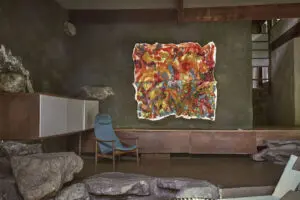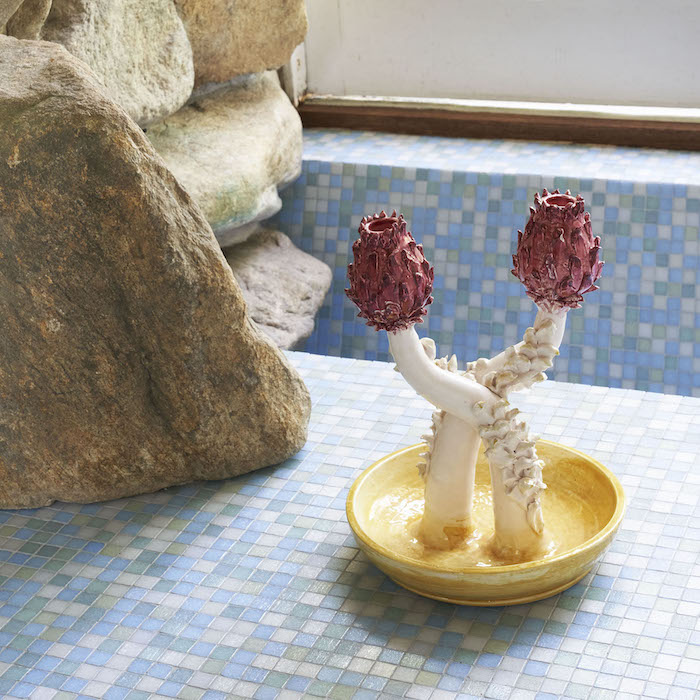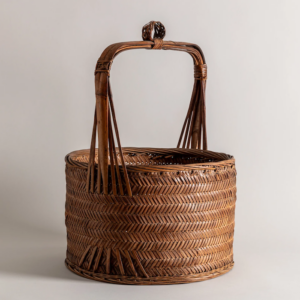Artists visit retreat and return with pieces to fit the space
After opening a studio on the Upper East Side in 1928, Russel Wright and his wife, Mary, crafted earth-toned home goods by hand, intending to produce them on an industrial scale.
Despite designing for mass-market success, they found inspiration in nature. Their retreat in Philipstown centers on a house and studio situated atop a granite quarry wall just so.
Surrounded by 77 acres of sculpted landscape (Wright moved boulders with a derrick to create a pool and waterfall), the hard-angled glass and wood structures somehow fit seamlessly into the setting.
Mary, a distant cousin of Albert Einstein, contributed to the concept but died in 1952, 10 years before the complex’s completion. Wright tinkered with the property until his death in 1976, installing interior artworks that blended natural and artificial elements.
The aesthetic is reflected in this season’s annual exhibition at Manitoga, The Source of Everything, curated by Kate Orne, publisher of Upstate Diary, an $18 print magazine with heft that has expanded its editorial focus from the Hudson River Valley to an international gaze. Orne featured Manitoga in 2015 and selected art inspired by nature.

Most of the 20 small works on display in the home and studio are created for their settings. “It’s important to respect the space and not overwhelm it,” says Orne. “These pieces balance with what Wright created and are a complement to the conversation, not an intrusion.”
In years past, Manitoga/The Russel Wright Design Center allowed a visual artist or two to scope out the place for a while and develop site-specific works. For this year’s showcase, several artists visited together to absorb the vibe and visualize where their work would be presented.
Three collaborative sculptures by Kieran Kinsella and Rodger Stevens blend hammered, riveted brass and wood. “Dialogbject #1 (Alicorn)” resembles a tiny xylophone.
Other pieces include ceramic artichoke candleholders by Lola Montes, ceramic sculptures with interlocking panels from Sam Falls, a squat bronze work by Myra Mimlitsch-Gray and Sagarika Sundaram’s hand-dyed, wool and wire abstract wall hanging.
Stevens also contributes a solo wall sculpture that outlines its title, “Portrait of a Family as a Landscape.” Before Mary Wright died, the couple adopted a daughter, Ann, who grew up in the house and runs a catering company in the area.
Jeremy Anderson’s work occupies the integrated kitchen and dining room on the home’s lower level. His dense, glazed stoneware sculpture, “Piccolo 147,” resembles the folds of a rose.
A couple of metallic-looking “Swimming Hole Platters” hark to the water outside the window and to Wright’s mass-produced decorative serving plates with a sheen (including a color he called gunmetal, on display in Cold Spring; see below).
A Visit to Cold Spring
A handful of Russel and Mary Wright’s creations, along with items he picked up in Asia, are on display at Studio Tashtego on Main Street in Cold Spring.
Stories from a Collection, on view through Aug. 4, features selections from the Russel Wright Design Center’s extensive cache of artifacts.
Andy Warhol collected the couple’s work. Martha Stewart championed their 1950 book Design for Modern Living, which blasts pretense, praises informality and promotes a democratized design ethos for middle-class homes — including the now-popular “great room” that integrates the kitchen, dining area and living (or family) room.
Many items embrace imperfection, like the two bowls with drip marks in the glazing that, according to the wall label, Russel Wright likely collected in Japan.
Some pieces in a sky-blue tableware line produced in 1952 evoke American Modern’s style, but not the sugar bowl with an ill-fitting lid. Several tan plates contain baked-in patterns on the surface that resemble a coating of powdered sugar. One looks like the top of a cake.
The Russel Wright Center seeks other local partners, says Allison Cross, Manitoga’s executive director. “Julia [Caldwell, owner of Studio Tashtego] shares a similar passion for textured household items and the notion that good design can enhance people’s lifestyles, so this one was easy.”
Studio Tashtego, at 158 Main St., is open from 10 a.m. to 6 p.m. Wednesday to Sunday. Call 917-794-4643 or visit studiotashtego.com.
Old photos show the kitchen/dining room shelves filled with the couple’s most popular and recognizable creation, the American Modern tableware line, introduced in 1939.
Spouts on the creamers, teapots and water pitchers stick out like bird beaks. The style stuck around due in part to its influence and widespread licensing, which Mary helped pioneer and sustain.
Russel Wright, an indefatigable toiler, also lionized leisure. A living paradox, he obsessed on Manitoga and installed a jumble of whimsical juxtapositions between the natural and the artificial.
Interior adornments include hemlock needles mashed into the plaster of one of the house’s walls and butterflies pressed between plexiglass screens. After he dabbed sand and epoxy paint onto another wall, a good portion of the grains fell on the floor. He left it up anyway.
“I first came to Manitoga in 2011 and every time I return, I discover something new,” says Orne. “The place keeps pulling me back.”
Manitoga is located at 584 Route 9D in Philipstown. The Source of Everything is on view Fridays to Mondays through Aug. 19 during 90-minute guided tours. Tickets are $30 at visitmanitoga.com. Children must be at least 10 years old to attend.




